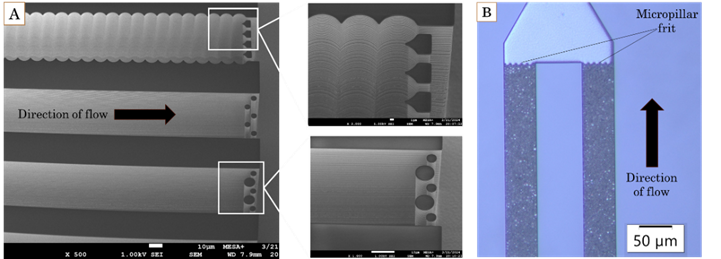The miniaturization of liquid chromatography (LC) methods can significantly boost separation performance while reducing separation time, driving technological advances in column efficiency. In addition, there is a growing demand for portable LC analysis, particularly through integration into Lab-on-Chip systems, paving the road for point-of-care testing or in-situ detection of toxic compounds. Concomitantly, miniaturisation can reduce solvent waste by at least a factor 4 compared to traditional columns, favouring the inevitable transition towards a greener and more sustainable chemical industry [1]. This work focuses on developing novel column formats (Fig. 1) by leveraging microfluidic technology and silicon-based micromachining. In particular, the on-chip ordered assembly of microparticles is explored, which can subsequently be utilized as a miniaturized LC chip.

Figure 1: (A) SEM photo of parallel connected microfluidic channels with different frit geometries. (B) Two interconnected channels, packed with 5 μm monodisperse silica particles.
Assignment
The assignments can be tailored to the student background and interest. Potential research topics are not limited to:
- Examine the on-chip assembly of silica particles as a function of various parameters, e.g., particle size, concentration, column design
- Perform chromatographic tests on particle-packed miniaturized columns
- Numerical modelling of the particle assembly process in a microfluidic column using open source software
References
- Vankeerberghen, B., Verloy, S., Jimidar, I. S. M., Gardeniers, H., & Desmet, G. (2023). Structured microgroove columns as a potential solution to obtain perfectly ordered particle beds. Journal of chromatography. A, 1700, 464031. https://doi.org/10.1016/j.chroma.2023.464031
Contact information
Ignaas Jimidar; E-mail: i.s.m.jimidar@utwente.nl
Mitch de Waard; E-mail: m.t.j.dewaard@utwente.nl
